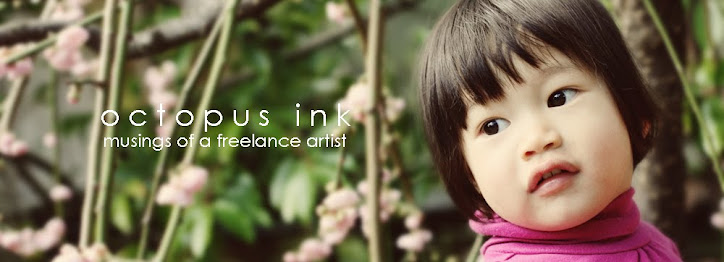
 This is an old art work of mine, from 2003 or 2004. It is one of a series of 9 paper panels (made from smushing paper pulp into plaster mold that was cast from a clay relief sculpture). The middle panel featured a green rabbit inside a test tube - this is Alba, the first rabbit genetically altered (by the inclusion of the Green Fluorescent Protein, GFP) in the name of art, not science by artist: Eduardo Kac. So here, Alba, if released in the wild, might meet one of 2 life fates: her mutation is an advantageous, resulting in all future rabbits possessing GFP, or the opposite; GFP may render her a disadvantage, and she is eliminated from the gene pool.
This is an old art work of mine, from 2003 or 2004. It is one of a series of 9 paper panels (made from smushing paper pulp into plaster mold that was cast from a clay relief sculpture). The middle panel featured a green rabbit inside a test tube - this is Alba, the first rabbit genetically altered (by the inclusion of the Green Fluorescent Protein, GFP) in the name of art, not science by artist: Eduardo Kac. So here, Alba, if released in the wild, might meet one of 2 life fates: her mutation is an advantageous, resulting in all future rabbits possessing GFP, or the opposite; GFP may render her a disadvantage, and she is eliminated from the gene pool.This was my first foray into bio-art, which as you can see, is a totally different genre from scientific illustration. Whereas Sci Ill is all about accurate scientific depiction and clarification, this "Bio-Art" is all about concept, and not necessarily based on science, but rather the perception of science. But as you'll see, this work is relatively very muted form of the possible outcomes when we mix art with science.
Way back then, while in art grad school, I attended a Bio-Art conference in Montreal. I'd say 99% of attendees were artists, and the few scientists that were there were... pretty out there. More outrageous projects included:
Performance art: the eating of tissue cultured frog legs (to avoid killing of animals) while dressed in lab coats and roasting the frog legs over bunsen burners
Performance art: the dissection of gross masses of flesh (which were infact, human-composed amalgamates of butcher shop discards to resemble weird meat sculptures) - again in lab coats with scalpels in a sterile room
And less outrageous:
Audio Art: Amplification of all the sounds coming from a termite mound
Many artists... fulfilled the artist stereotype. European accented, they turned their nose up at scientists (even though scientists' techniques/discoveries were employed in artists' works?), wore outlandish outfits. I spoke to an artist - he wore Red Capris and yes had a Euro accent - and he was surprised that I had a science background. He commented: "Usually, scientists don't even bother listening to us." And then went on to describe his interaction with scientists, which included a Electron Microscoper who excitedly shared his "art" with Red Capris. Red Capris told the EM: "This isn't art! You have merely captured images!" or something of the like. RC then sighed and told me that scientists don't understand what art is really all about. I didn't get it then, but I think I know now, that what he was referring to was Concept. There was no concept behind an electron-micrograph image. Nothing to push buttons and to make the viewer Think or Question (beyond: Uh, what is that?). There has been no interpretation in the process, nor will there be while viewing the image. Alba the GFP bunny was conceptual art; though she looked like a normal white rabbit (unless under blacklights), the Idea of using Genetics to Make Art was completely novel.... and makes you think: why not use genetics to make art? Is there anything wrong with that?
Does all this make sense? I've spent years thinking about this stuff, I'm trying to condense it.
So, I bring all this up because I am a judge for a "Science as Art" contest, hosted by BIOeasi:Bio Education and Art for Science Innovation, based in San Diego. The deadline for judging the 2010 competition is tomorrow, and naturally as a procrastinator I just got around to looking at the entries. And I was reminded of Red Capris. Many of the entries were in fact, digitally captured images (DCI) of cells and what not. While it is remarkable that we can now see things that small, the images did not inspire anything else. Now if a DCI had interesting dyes, a dynamic composition, and it was obvious that it wasn't simply a photo taken by someone who happened to have the skill and access to cells and machine, I gave that more credit. But also... I am a stickler for traditional media. Illustrations, prints, drawings - where it takes more than recognizing a powerful image AND concept but ALSO having the talent to convey that through the hands - that's what I appreciate.
I'll leave you with the description of one last bit of Bio Art from the last decade. You might find this disturbing. It's the Cloaca project. It consists of a machine that simulates the human digestive tract. Performance art: top chefs feed it gourmet food, and the food is made into, well, poop. The poop is sold as high end art (sculpture, I guess). Really. If you really want, youtube "Eurotrash Cloaca" but beware, it is all about poo. The Concept? A new appreciation for our remarkable digestive systems. Of course this art piece is based in Europe. And the only lab to undertake the Alba GFP project? In France.

No comments:
Post a Comment